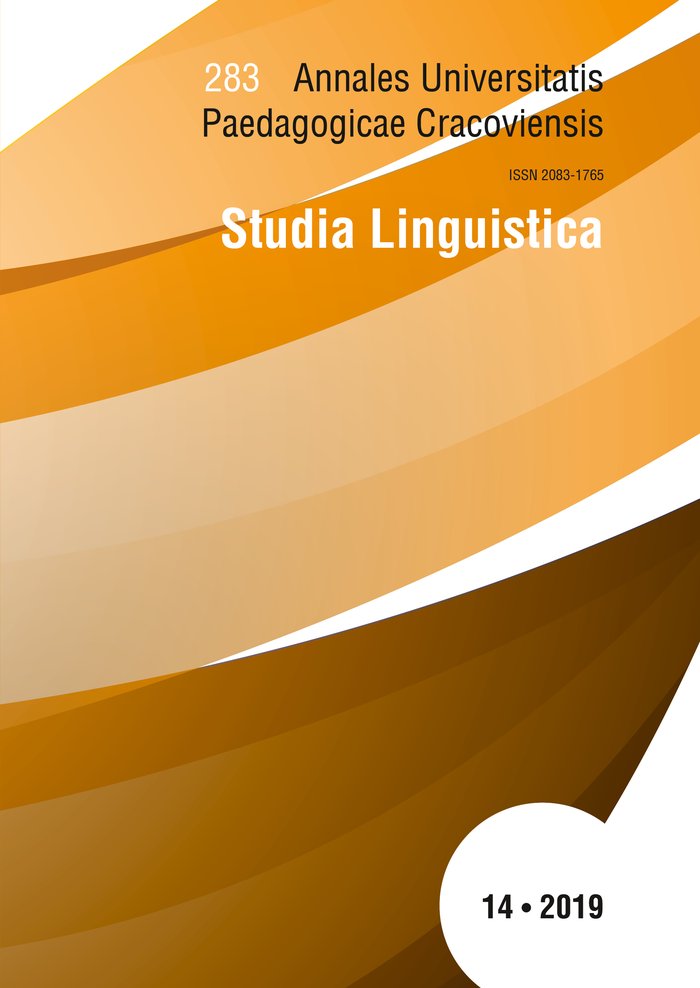Components exposing the feminine quality in the names of associations in the Second Polish Republic
Main Article Content
Abstract
The material basis of the paper are the names of Polish female associations from the 30s of the 20th century. The analysis involves components used to expose feminine qualities - general names (kobieta, pani, niewiasta - ‘woman, lady’), as well as detailed ones, which were categorised according to the information they contain. These are the elements of the world, which in addition to gender, constitute a basis for communality of the members: social and professional status, educational background, participation in military activities, social activity sphere, or common interests. The material presented in the paper shows that in the Second Polish Republic the need for exposing femininity and emphasising communality was very strong in the names of associations.
Downloads
Article Details
Author, submitting a text to the editorial board of the journal “Annales Universitatis Paedagogicae Cracoviensis. Studia Linguistica", certifies that the content of the article has not been published so far and that the work does not violate in any way the copyright or related rights of other person, as well as other rights of third parties, and that no one's rights to the work (or any part thereof) have been missed. After signing the contract, the property rights to the published materials are transferred to the Scientific Publisher of the University of the National Education Commission, Krakow.
“Annales Universitatis Paedagogicae Cracoviensis. Studia Linguistica” is an open access journal, and all its content is made available free of charge to users and institutions under the Creative Commons CC-BY-NC-ND 4.0 license (attribution, non-commercial use, no derivative works). Under this license, the authors agree that their work may be lawfully reused for any purpose, except for commercial purposes, without the prior consent of the author or publisher. Everyone can read, download, copy, print, distribute and process these works, provided that the author's marking and the original publication place are correct. Published texts may not be used to create derivative works (e.g. to translate and publish in another language without the consent of the publisher). This is in line with the BOAI (Budapest Open Access Initiative) definition. "Studia Linguistica" does not charge for submitting or processing articles.
References
Breza E., 1998, Nazwy obiektów i instytucji związanych z nowoczesną cywilizacją (chrematonimy), [w:] Polskie nazwy własne. Encyklopedia, red. E. Rzetelska-Feleszko, Warszawa–Kraków, s. 353–361.
Google Scholar
Decyk W., 1999, Nazwy organizacji i instytucji europejskich w polszczyźnie, „Poradnik Językowy”, z. 4, s. 18–29.
Google Scholar
Gałkowski A., 2007, Socjoideonimy a chrematonimy – miejsce nazw organizacji i inicjatyw społecznych w dynamice onimicznej języka, [w:] Nowe nazwy własne – nowe tendencje badawcze, red. A. Cieślikowa, B. Czopek-Kopciuch, K. Skowronek, Kraków, s. 495–508.
Google Scholar
Gałkowski A., 2011, Chrematonomastyka jako autonomizująca się subdyscyplina nauk onomastycznych, [w:] Chrematonimia jako fenomen współczesności, red. M. Biolik, J. Duma, s. 181–193.
Google Scholar
Godek M.J., 2005, Jadwiga Zamoyska i jej program pracy społecznej, „Człowiek w Kulturze” XVII, s. 241–255.
Google Scholar
Gumuła T., 1996, Działalność oświatowo-wychowawcza Cecylii Plater-Zyberkówny (1853–1920), „Studia Pedagogiczne. Problemy Społeczne, Edukacyjne i Artystyczne”, t. XI, s. 167–173.
Google Scholar
Horyń E., Zmuda E., 2007, Nazwy duszpasterstw akademickich działających w Archidiecezji Krakowskiej, „Małopolska” XIX, s. 1–10.
Google Scholar
Jakus-Borkowa E., 2003, Chrematonimia kosmiczna. Nazewnictwo instytucji astronomicznych, programów badawczych, obserwatoriów do badania Układu Słonecznego oraz katalogów gwiazd, [w:] Metodologia badań onomastycznych, red. M. Biolik, Olsztyn, s. 592–609.
Google Scholar
Jakus-Borkowa E., 2004, Polskie nazewnictwo kosmiczne, Opole.
Google Scholar
Kałwa D., 2001, Kobieta aktywna w Polsce międzywojennej, Kraków.
Google Scholar
Kantyka S., 2013, Stowarzyszenia w ustroju społeczno-politycznym Polski w latach 1918–1939. Studium historyczno-politologiczno-prawne, Katowice.
Google Scholar
Karamańska M., Młynarczyk E., 2018a, Identyfikacja osób w nazwach organizacji kombatanckich II Rzeczpospolitej, „Słowo. Studia Językoznawcze”, nr 9, s. 58−67.
Google Scholar
Karamańska M., Młynarczyk E., 2018b, Językowy obraz troski o II Rzeczpospolitą utrwalony w nazwach stowarzyszeń, „Annales Universitatis Paedagogicae Cracoviensis. Studia Linguistica” XIII, s. 13−24.
Google Scholar
Kowalik K., 2011, Nazwy własne polskich współczesnych towarzystw naukowych i kulturalnych, „Annales Universitatis Paedagogicae Cracoviensis. Studia Logopaedica” IV, Język – kultura – edukacja, s. 277–286.
Google Scholar
Krzysztofek K., 2014, Stowarzyszenia katolickie w Krakowie w latach 1918–1939. Studium historyczno-prawne, Kraków.
Google Scholar
Krzyżanowska N., 2012, Kobieta w (polskiej) sferze publicznej, Toruń.
Google Scholar
Łysko M., 2015, Udział kobiet w życiu publicznym II Rzeczypospolitej Polskiej, „Miscellanea Historico-Juridica” XIV, z. 1, s. 381–401.
Google Scholar
Małocha-Krupa A., 2018, Feminatiwum w uwikłaniach językowo-kulturowych, Wrocław.
Google Scholar
Sierakowska K., 2015, Kobieta i mężczyzna w społeczeństwie II RP, [w:] „Metamorfozy społeczne”, t. X, Społeczeństwo międzywojenne: nowe spojrzenie, red. W. Mędrzecki, J. Żarnowski, s. 167−188.
Google Scholar
Suski P., 2002, Stowarzyszenia w prawie polskim, Warszawa.
Google Scholar
Suski P., 2008, Stowarzyszenia i fundacje, Warszawa.
Google Scholar
Szelewski M., 2004, Pragmatyczna interpretacja ergonimów komercyjnych na przykładzie nazw szkół językowych, „Onomastica” XLIX, 165−179.
Google Scholar
Woźniak E., 2014, Język a emancypacja, feminizm, gender, „Rozprawy Komisji Językowej ŁTN”, t. LX, s. 295−312.
Google Scholar
Wójcik U., 2011, Nazwy polskich organizacji pożytku publicznego, „Onomastica” LV, s.189-197.
Google Scholar
